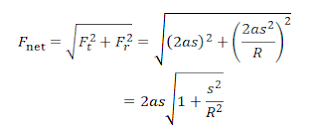Work power energy is the most important chapter when it comes to mechanics, for JEE (Advanced). The chapter is quite tricky and takes a lot of time and devotion on your part to understand and master. But this chapter is a complete gold medal for almost all the questions of the mechanics can be solved by the work power energy approach if you master this topic..
Q1.A body is acted upon by a force which is inversely proportional to the distance converted. The work done will be proportional to
Q2.A 1 kg stone at the end of 1 m long string is whirled in a vertical circle at a constant speed of4 ms^(-1). The tension in the string is 6 N when the stone is
Q3. A point mass of 1 kg collides elastically with a stationary point mass of 5 kg. After their collision, the 1 kg mass reverses its direction and moves with a speed of 2 ms^(-1). Which of the following statements(s) is/are correct for the system of these two masses?
Solution
As the speed of mass is uniform hence, net power will be zero.
As the speed of mass is uniform hence, net power will be zero.
Q5.A particle is released one by one from the top of two inclined rough surfaces of height h each. The angles of inclination of the two planes are 30° and60°, respectively. All other factors (e.g., coefficient of friction, mass of block, etc.) are same in both the cases. Let K1 and K2 be the kinetic energies of the particle at the bottom of the plane in the two cases. Then
Solution
Work done by friction: W=(μmg cosθ )S =(μmg cosθ ) h/sinθ =μmgh cotθ Now cot〖θ1 〗=cot〖30°〗=√3 cot〖θ2 〗=cot〖60°〗=1/√3 i.e., kinetic energy (KE=mgh-W) in first case will be less
Work done by friction: W=(μmg cosθ )S =(μmg cosθ ) h/sinθ =μmgh cotθ Now cot〖θ1 〗=cot〖30°〗=√3 cot〖θ2 〗=cot〖60°〗=1/√3 i.e., kinetic energy (KE=mgh-W) in first case will be less
Q7.Two identical particles, A andB, are attached to a string of length 2l,A to middle and B to one of the ends. The string is whirled in a horizontal circle, with the end O fixed. If the kinetic energy of B relative to A is E, then the absolute kinetic energies of A and B are
Solution
From v=ωr, speed of B will be double of A, hence KE of B is 4 times that of A
From v=ωr, speed of B will be double of A, hence KE of B is 4 times that of A
Q8.If a number of forces act on a body and the body is in static or dynamic equilibrium, then
Solution
When a number of forces act on a body and the body is in static or dynamic equilibrium (it means F_net=0), then individual forces may do the work, but net work done by all the forces will be zero, because KE of body is not changing
When a number of forces act on a body and the body is in static or dynamic equilibrium (it means F_net=0), then individual forces may do the work, but net work done by all the forces will be zero, because KE of body is not changing
Q9.The kinetic energy K of a particle moving along a circle of radius R depends upon the distance s as K=as^2. The force acting on the particle is
Q10. A person lifts a bucket full of water by means of light rope from a well. Select the incorrect statement
Solution
Here work done by the person is positive, because energy of the person will decrease in lifting the bucket. It means work done on the person should be negative. Also if work done on the person were positive, then his energy should have been increased.
Here work done by the person is positive, because energy of the person will decrease in lifting the bucket. It means work done on the person should be negative. Also if work done on the person were positive, then his energy should have been increased.














